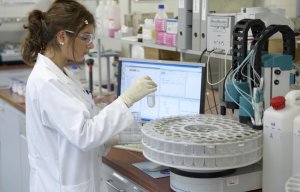
New Standard 100 by Oeko-Tex test criteria come into force
During laboratory tests, the new regulations must now be complied with several criteria, including chemicals management.

13th April 2015
Innovation in Textiles
|
Zurich
After the expiry of the usual three-month transition period, the test criteria and limit values for Oeko-Tex Standard 100 that were published at the start of the year came definitely into force on 1 April 2015.
During laboratory tests, the following new regulations must now be complied with several criteria, including chemicals management. The latest version of the Oeko-Tex Standard 100 test criteria and limit values can be viewed at any time at www.oeko-tex.com/limitvalues .
The limit value for the sum of nonylphenol (NP), octylphenol (OP), nonylphenol ethoxylates (NP(EO)1-20) and octylphenol ethoxylates (OP(EO)1-20) has been significantly reduced in all Oeko-Tex product classes.
With this further reduction, Oeko-Tex is once again contributing to the complete exclusion of NP and OP, as well as alkylphenol ethoxylates, from textile production. Thanks to the globally introduced company audits that form part of every Oeko-Tex certification, all the companies participating in the Oeko-Tex system will also be made aware of these particularly environmentally harmful and problematic substances in auxiliary agents.
The specifications for perfluorooctanoic acid (PFOA) have been set much more stringent. This is to ensure that the Oeko-Tex Standard 100 covers the applicable legal regulation for PFOA in Norway for textiles, carpets and other coated consumer goods.
The limit value for perfluorooctane sulfonates (PFOS) has also been changed to < 1.0 μg/m² in all product classes (previously 1.0 μg/m²).
With these two provisions, Oeko-Tex specifically supports the Zero Discharge of Hazardous Chemicals (ZDHC) initiative and the Detox campaign of international brands and retailers that have committed themselves to exclude hazardous chemicals from the production process by 2020.
Effective immediately, there are differences in the check for chromium (VI) in leather and in other materials. For leather materials, EN ISO 17075, which considers special matrix effects for the testing of leather, will be taken account of as well as the new European legal regulation (EU) no. 301/2014 and regulation (EC) no. 1907/2006 (REACh), respectively.
The quantification limit for chromium(VI) is defined as 3.0 mg/kg. The requirement for leather materials with regard to chromium(VI) is therefore < 3.0 mg/kg in every product class of the Oeko-Tex Standard 100. For other materials, the previous requirement of < 0.5 mg/kg continues to apply.
As is already the case in product classes I to III, and after an applicable transition regulation until 31 December 2015, only flame-retardant products that have up to now and by current technological standards been deemed harmless to health and that are included in the list of products accepted by Oeko-Tex can be used in product class IV (decoration materials) from January 2016. In this case, flame-retardant products may also be permitted for use only in product class IV.
The limit value for the total content of cadmium after total digestion of the test sample has been reduced to 40 mg/kg as standard in all product classes.
This ensures that the Oeko-Tex Standard 100 meets the requirements of the US state of Washington's Children’s Safe Products Act (CSPA) for cadmium – the strictest law worldwide in this area.
Formamide has been added to the standard as a new test substance for compact foams and foamed plastics such as EVA, PVC, etc. under the heading Solvent Residues. The limit value is defined at 0.02 % in all product classes.
This ensures that due consideration is given to the fact that formamide is included in the ECHA-SVHC candidate list (substances of very high concern) and that there are legal provisions for specific materials/items in France.
The footnote for arylamines under the heading "Other Chemical Residues" has been changed to: "For all materials containing polyurethane or other materials which may contain free carcinogenic arylamines". This provides further clarification that materials that contain the free carcinogenic arylamines listed in Annex 5 cannot be certified.
Dihexyl phthalate, branched and linear, and diisohexyl phthalate have additionally been included in the phthalates/softeners section of the Oeko-Tex Standard 100 in all four product classes. This ensures that due consideration is given to the fact that dihexyl phthalate, branched and linear (CAS no. 68515-50-4) is an SVHC candidate substance.
C.I. Pigment Red 104 (lead chromate molybdate sulphate red) and C.I. Pigment Yellow 34 (lead sulfochromate yellow) have been added to the list of colourants classed as carcinogenic and that are therefore prohibited in Annex 5 of the Oeko-Tex Standard 100.
Both colourants, which are also included in the REACh SVHC candidate list and in Annex XIV of REACh, have been tested as part of the Oeko-Tex Standard 100 for many years now and are already prohibited and excluded.
The exceptional regulation for solvent residues of 1-Methyl-2-pyrrolidone (NMP) with regard to spun dyed fibres used for personal protective equipment (PPE) was transferred from the Oeko-Tex Standard 100 to the set of rules of the Oeko-Tex Standard 100 supplement for special articles.

Business intelligence for the fibre, textiles and apparel industries: technologies, innovations, markets, investments, trade policy, sourcing, strategy...
Find out more